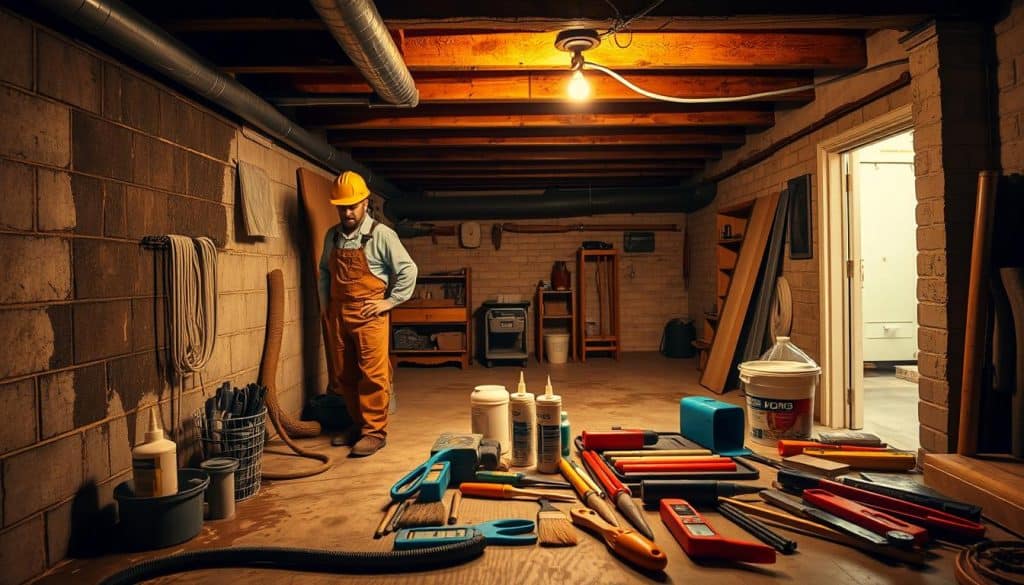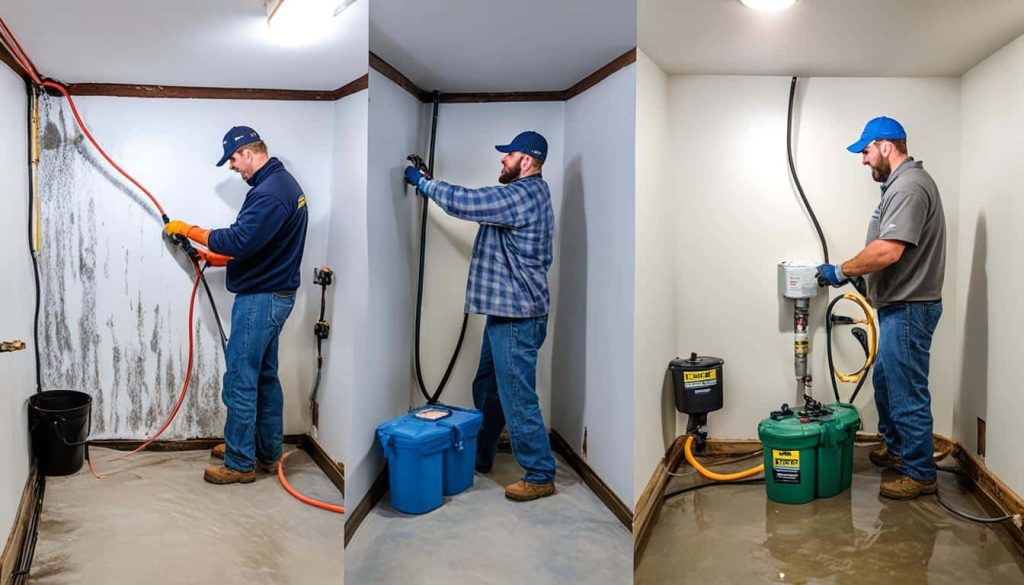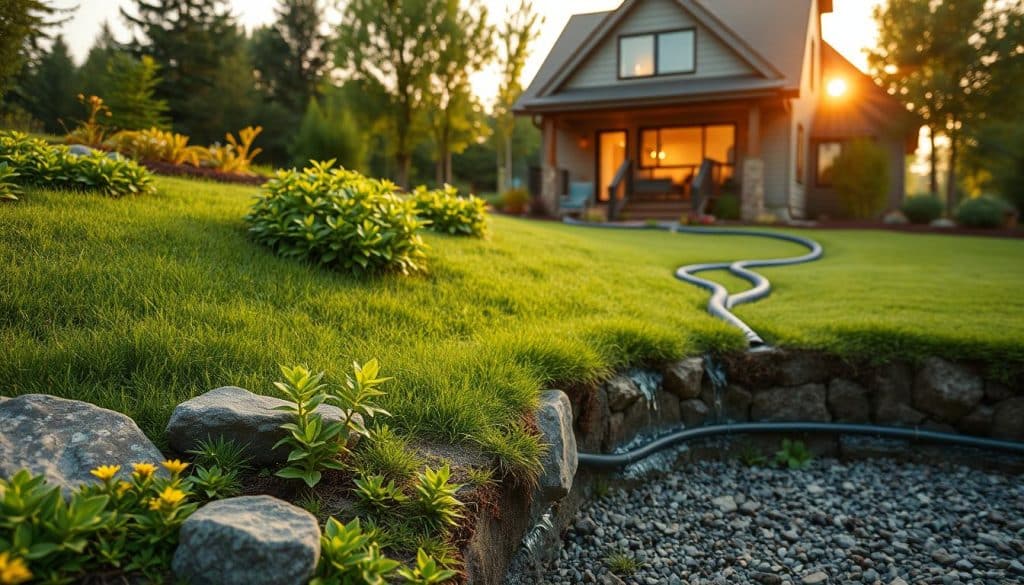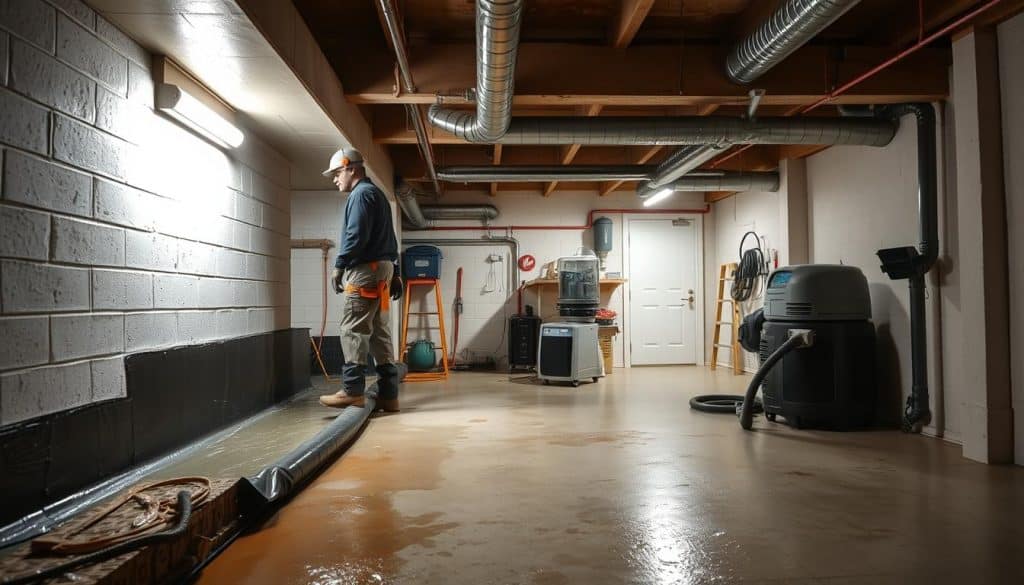Table of Contents
Have you ever thought about the hidden water damage under your home? It can harm your home’s value and structure. What is the Best Method for Basement Waterproofing? Knowing the best way to waterproof your basement is key to avoiding expensive fixes.
With nearly 50% of homes facing moisture issues in their basements, it’s vital to learn about the latest techniques. This article will explore different options, like exterior and interior solutions. You’ll find the best fit for your situation and budget. The right waterproofing can prevent major damage and save you money in the long run.



Key Takeaways
- Almost 50% of homeowners face moisture problems in their basements.
- Effective waterproofing protects against mold, structural deterioration, and costly repairs.
- Exterior and interior waterproofing methods each offer unique advantages.
- Understanding various waterproofing techniques helps tailor solutions to individual needs.
- Investing in high-quality waterproofing can prevent severe damage and decrease long-term costs.
Understanding Basement Waterproofing
Basement waterproofing is key for homeowners, mainly in flood-prone areas. Knowing what basement waterproofing is helps make better choices to protect your home. It uses various methods to stop water from getting into the basement. This is vital for keeping your home and foundation strong.Definition of Basement Waterproofing
Basement waterproofing includes using sealants, drainage systems, and special construction methods. Homeowners can pick from exterior or interior waterproofing. Exterior is often seen as the best long-term choice, while interior directs water to drainage systems. Using good waterproofing methods can lower the chance of moisture and mold. It also helps avoid costly repairs to your foundation.Importance of Effective Waterproofing
Effective waterproofing is very important. It keeps your home safe from water damage and boosts its value. It also lets you use your basement as living space, improving your family’s life. With climate change, protecting your home with waterproofing is more urgent. Ignoring waterproofing can lead to high costs later. So, investing in it early is a smart move.
Common Causes of Basement Water Issues
It’s important to know why basements get water to prevent damage and health risks. Many things can cause water to build up in basements. Finding these problems early can help avoid expensive fixes and health issues.Groundwater Pressure
Groundwater pressure is a big reason for basement water problems. When there’s too much water in the soil, it pushes against basement walls. This can make water leak through cracks, causing damp or flooded basements.Poor Drainage Systems
Bad drainage systems let water get into basements. If rainwater can’t be moved away from the foundation, it pools and leaks in. Homes with uneven yards or wrong downspout directions are more likely to have these problems.Cracked Walls and Foundations
Cracks in walls and foundations let water into basements. It’s key to check for and fix these cracks quickly. This helps stop water damage and keeps the building strong.Overview of Waterproofing Methods
Basements often face water problems due to the environment. Knowing about waterproofing methods is key for homeowners. There are two main ways: interior and exterior waterproofing. Each has its own strategies and benefits, tailored to a basement’s needs.Interior vs. Exterior Waterproofing
Interior solutions deal with water that’s already in the basement. They include drainage systems, sump pumps, and sealants. These steps help keep the basement dry by redirecting water. They’re good for fixing small leaks and issues with drainage or groundwater. Exterior methods aim to stop water from getting in. This involves digging around the foundation and applying waterproof membranes. It’s more expensive but offers lasting protection and lowers water damage risks.Active vs. Passive Systems
Active systems use mechanical devices like sump pumps to remove water. They’re great for keeping basements dry, even when it rains a lot. They’re perfect for areas with high groundwater levels. Passive systems use barriers to keep water out. They include drainage outside the foundation and sealants to block moisture. Knowing the difference helps homeowners pick the best solution for their basement.French Drains: A Reliable Solution
French drains are a smart way to handle water around your home’s foundation. They are designed to move surface and groundwater away, stopping moisture buildup. Knowing how they work helps homeowners see their value in keeping property dry.How French Drains Work
French drains have a simple design. They consist of a trench filled with gravel and pipes with holes. This setup captures extra water and moves it away from the foundation. It lowers water pressure on basement walls, cutting down on leaks and damage.Benefits of Installing French Drains
Installing French drains has many advantages. They control water buildup, preventing mold and keeping the air clean. They also reduce pressure on the foundation, saving it from damage and costly fixes.Installation Process
Putting in a French drain takes a few steps. First, a trench is dug around the basement. Then, a pipe with holes is placed in it, covered with gravel. The area is graded to help water flow to the drain, making it a key part of waterproofing.Sump Pumps for Basement Protection
Sump pumps are key for homes with basements to avoid water damage. They remove water from a sump basin, lowering flood risks. In rainy areas or where water is high, sump pumps protect living spaces from moisture.Functionality of Sump Pumps
A good sump pump can take out up to 2,000 gallons of water per hour. This is vital for keeping basements dry. About half of all basements will face water problems at some point. Installing a sump pump early can stop damage and mold. Mold can start in just 24 to 48 hours in damp places.Choosing the Right Sump Pump
Choosing the right sump pump depends on your basement’s size and water needs. You can pick between pedestal and submersible pumps. Pedestal pumps are cheaper and easier to fix but can be louder. It’s important to pick a pump that fits your needs for good water management.
Maintenance Tips
Regular upkeep is key for sump pumps to work right in emergencies. Get annual checks from pros to spot problems early. Homeowners should clean the pump, check the discharge lines, and test the power.Drainage Systems and Gutters
Proper drainage systems are key to protecting your home from water damage. They keep water away from your foundation and prevent moisture buildup. This stops mold growth and structural problems.Importance of Proper Drainage
Effective drainage systems stop water from pooling around your home’s foundation. Groundwater pressure can cause cracks and instability in foundation walls. By directing water away, you lower the risk of basement flooding and other water issues.Installing Gutter Systems
Installing gutter systems is vital for managing rainwater. They help divert water away from your home. Downspouts should be at least 10 feet from your home to prevent water pooling.Regular Maintenance Practices
Regular maintenance is important for drainage systems and gutters. Check for clogged or damaged drains to ensure water flows properly. Cleaning gutters and maintaining systems keeps them working well, avoiding costly damage.Waterproofing Sealants
Waterproofing sealants are key to keeping basements dry. There are many types to choose from, each with its own strengths. Knowing how to use them right is important for lasting protection.Types of Sealants Available
Hydraulic cement, silicate-based sealers, and elastomeric coatings are popular choices. Hydraulic cement seals cracks well. Silicate-based sealers make concrete strong against moisture. Elastomeric coatings stretch with the building, great for old homes.Application Techniques
Start by making the surface clean and dry. This helps the sealant stick better. The method depends on the sealant, like rolling or spraying. Always follow the instructions for best results.Long-Term Effectiveness
Waterproofing sealants can last for years if applied correctly. Products like Vapor-Tek 440 can block moisture for over 10 years. Lithi-Tek 9500, on the other hand, can last more than five years with proper use.The Role of Landscaping in Waterproofing
Landscaping is key to keeping your home dry. Using the right methods can lower water damage risks. It’s important to make sure water flows away from your home’s base. A slope of at least six inches over the first ten feet is best for drainage.Grading Your Yard Properly
Proper grading is essential to keep water away from your home’s base. It can cut down water intrusion by up to 80%. A good slope ensures rain and snowmelt flow away.Plant Selection for Water Control
Choosing the right plants is also important. Plants like oak and willow trees help manage soil moisture. Stay away from plants that hold moisture near your home’s base. These plants help keep your home dry and prevent water problems.Tips for Effective Drainage
Good drainage is vital for a dry basement. Use swales or dry wells to move water away. Permeable surfaces like concrete or asphalt absorb water better. Keep your gutters and downspouts clean. Extend them four to six feet from your home’s base to manage water flow.Choosing the Right Waterproofing Company
Finding a trustworthy waterproofing contractor is key to keeping your home safe from water damage. You need to think carefully about several factors for the best results. Knowing these can help you make smart choices and ask the right questions.Factors to Consider
When picking a waterproofing company, look at their reputation and experience. Check out what others say about them. Also, ask about their methods and if they use the latest technology and materials. This can make your waterproofing last longer and increase your home’s value.Questions to Ask Potential Contractors
Before you decide, make a list of important questions. Find out about their warranties and how long their work lasts. Ask about their past projects to see if they’re good at what they do. Make sure they understand your water problems and can solve them.Benefits of Working with Professionals
Choosing skilled professionals can lower the risks of basement water problems. They offer solutions that DIY methods can’t. Their knowledge can also improve your home’s air quality and reduce mold. Working with a reputable company means you get reliable results that last. This gives you peace of mind.Array of Solutions: Your Local Expert
Array of Solutions is your go-to for waterproofing and mold management. We’ve been in the business for over a decade, starting in 2007. Our team is dedicated to providing fast, reliable, and affordable solutions that meet your specific needs. We offer a variety of services, from interior sealants to advanced drainage systems. Our goal is to keep your home dry and protected.Services Offered by Array of Solutions
We provide thorough mold inspection and testing. Our waterproofing methods tackle different basement problems. We use top-notch interior sealants to block water entry points. Our exterior products are made to last the life of your home. Our team can install French drains and sump pumps to prevent flooding and mold.Why Choose Us for Your Waterproofing Needs?
Array of Solutions is committed to exceptional service. We’re EPA registered and have certified inspectors. Our team takes pride in custom solutions for your property. Customer testimonials show our dedication to quality. Many clients have seen their basements transformed into dry, usable spaces.Customer Testimonials
Our customers rave about our prompt service and success in solving water issues. They appreciate our team’s expertise and the improvements in their homes. Trust in our services brings peace of mind to our clients.Contact Information for Your Waterproofing Needs
Need help with basement waterproofing? Call Array of Solutions at (864) 710-6413 or email scmoldremoval@gmail.com. Our team is ready to help make your home drier and healthier.Reach Us by Phone or Email
Connecting with experts is key when you need waterproofing. Our contact info makes it easy to talk about solutions for your home. We aim to stop big problems before they start.Our Service Areas in South Carolina
Array of Solutions covers places like Greenville, Spartanburg, and Greer. We also serve Pickens, Easley, Clemson, Taylors, and Travelers Rest. No matter where you are, we offer top-notch basement waterproofing.Request a Free Consultation
Protect your home by asking for a free consultation. We’ll check your basement, find the best solutions, and share our insights. Don’t let water damage harm your home. Contact us today.
FAQ
What is the best method for basement waterproofing?
The best way to waterproof a basement is to use a mix of inside and outside methods. This includes sump pumps, drainage systems, and sealants. These help keep water out.
How do I know if I need basement waterproofing?
Look for signs like water stains, mold, and damp air. Also, check for cracks in walls or the foundation. Pooling water after rain is another sign.
What are some common basement waterproofing techniques?
Common methods include sump pumps and French drains. You can also use sealants inside and outside. Grading the yard helps direct water away.
What is the difference between interior and exterior waterproofing?
Interior methods deal with water after it gets in, using drainage and sealants. Exterior methods are proactive. They involve digging to apply barriers around the foundation.
How does a sump pump work?
A sump pump removes water from a sump basin in the basement. It stops flooding and controls groundwater levels.
What are the maintenance tips for a sump pump?
Keep your sump pump working by testing it often. Clean the basin and line. Check the power and float switch too.
How can I effectively prevent mold in my basement?
To stop mold, waterproof your basement well. Use dehumidifiers to keep humidity low. Also, make sure it’s well-ventilated.
What should I consider when selecting a waterproofing contractor?
Look at their experience and reviews. Check their warranties and how they solve waterproofing problems.
What are exterior waterproofing methods?
Exterior methods include applying membranes to the foundation. You can also dig around the foundation for better drainage. French drains help move groundwater away.
How important is proper grading for basement waterproofing?
Grading is key. It directs rainwater away from your foundation. Aim for a 6-inch slope over 10 feet to ensure water runs off.
How can I contact Array of Solutions for my waterproofing needs?
You can start by calling Array of Solutions at (864) 710-6413 or emailing them at scmoldremoval@gmail.com. They offer a supportive environment for those who are facing challenges. Our team is ready to help make your home drier and healthier.

